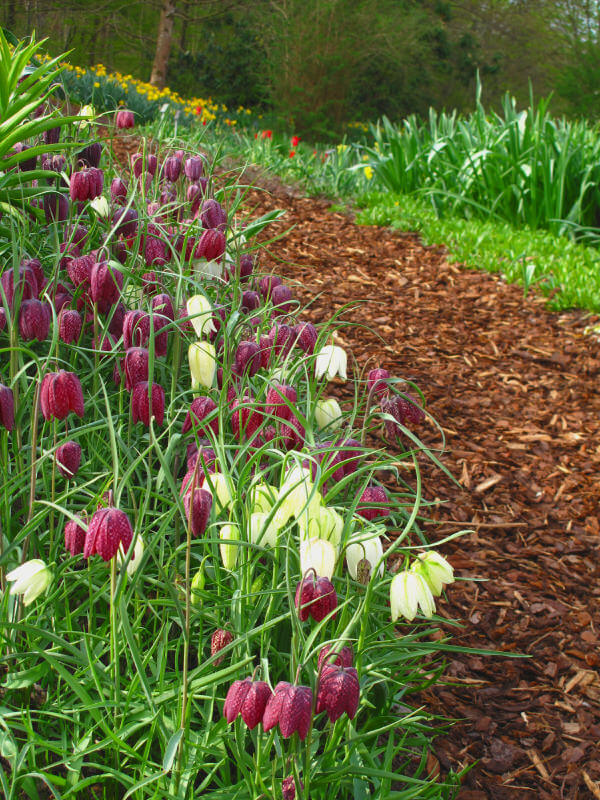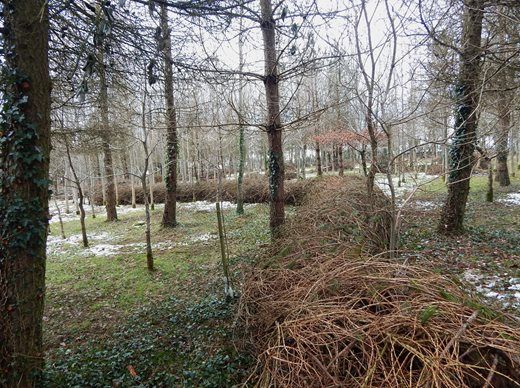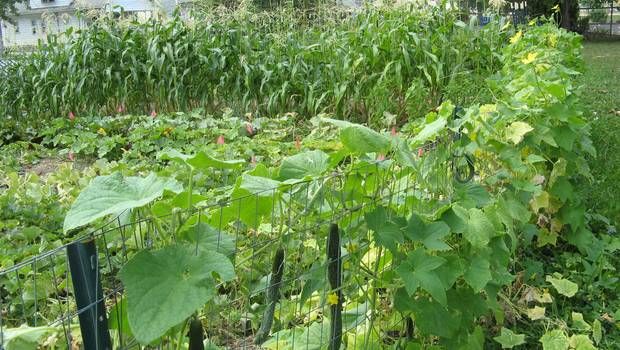Community Forest Garden – Analysis
Sector Analysis
Earth
MySoil app describes the soil at this site as Clayey Loam/Silty Loam.
The soil sample shows the soil to be Medium Loam.
| STRENGTHS Deep soil Undisturbed, fertile soil Plenty of leaf litter from trees – self mulching Good pedestrian access to site | WEAKNESSES Prone to waterlogging Can be slippery underfoot when wet Tricky to push barrows when wet |
| OPPORTUNITIES Water holding capacity of ground may mean that less watering is required Investigate varieties of plant that prefer wetter conditions Potential to build a seasonal pond | CONSTRAINTS Footpaths to site may prevent delivery of bulky loads (A small pick-up could access site) No tool storage Around a foot down is unknown industrial metal waste, excludes growing edible root vegetables on site. |
Air
| STRENGTHS Sheltered position | WEAKNESSES None observed |
| OPPORTUNITIES Can investigate less hardy plants | CONSTRAINTS None observed |
Fire
| STRENGTHS Southern, open end of the site receives a good amount of sun | WEAKNESSES The majority of the site is very shaded by existing trees • Frost pocket, especially Southern end |
| OPPORTUNITIES Coppicing, pollarding or felling some trees would let more light through Investigate varieties of plant that like to grow in shade | CONSTRAINTS We want to keep as many existing trees as possible Balance human/growing needs against natures needs |
I used SunCalc to map sunset and sunrise on both winter and summer solstice. However, due to tree cover at least half the site is in deep shade.
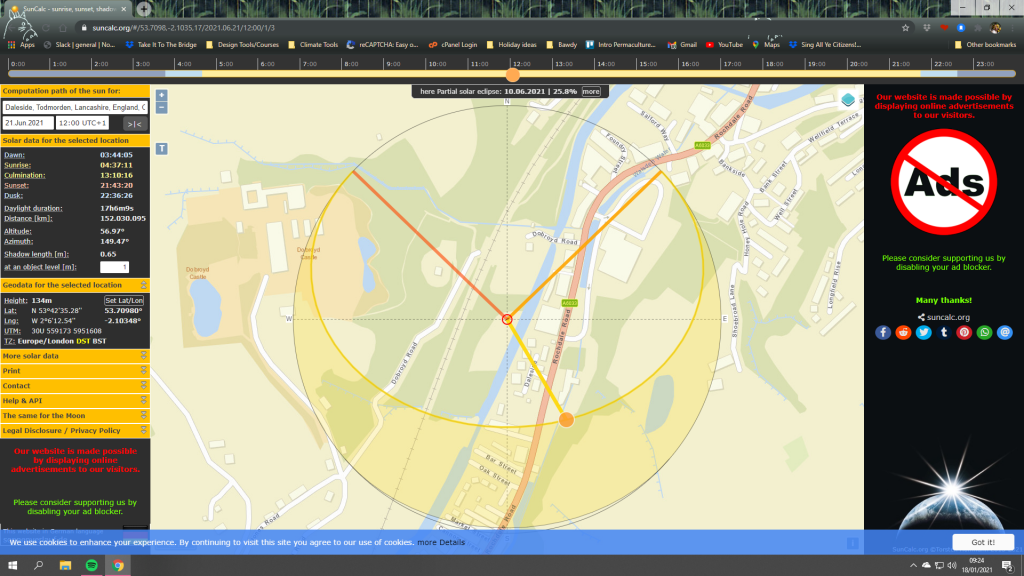
Sun positions at Summer Solstice 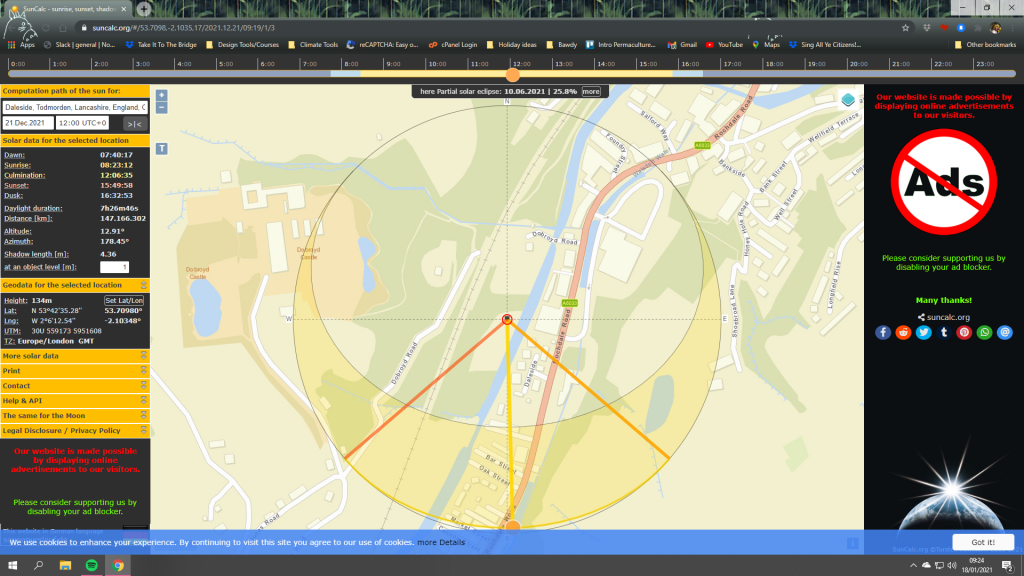
Sun positions at Winter Solstice
Water
| STRENGTHS Water is held in the soil – reducing need for irrigation | WEAKNESSES No sources of water on site Ground is prone to waterlogging, especially in Northern end |
| OPPORTUNITIES Could include a seasonal pond on site Investigate methods of planting that will keep plants out of waterlogged soil Canal is nearby, water could be used for watering | CONSTRAINTS No current structures on site that can be used for water capture |
Wild/Aesthetics/Views
| STRENGTHS No current evidence of deep damage Edible native plants on site Lots of frogs – slug control Healthy Minds allotment – other people on site to keep an eye out, or help out Great view of the canal | WEAKNESSES Invasive weeds on site need controlling Use of land be could be revoked Noise from trains Litter and dog faeces dropped on site from passers by If site looks unused, it won’t be treated with respect |
| OPPORTUNITIES Passing people = potential interest Investigate how site can engage with passing people Keeping it wild will encourage wildlife | CONSTRAINTS Need to keep footpaths accessible Access and security need to be balanced. |
Functions & Elements Analysis
To better understand what was needed on site I undertook a Functions & Elements analysis and then drew up a web of connections to ensure that all elements and functions were well supported.
| Function | Supporting Elements | Yields |
|---|---|---|
| Support Bio-Diversity | Trees | Wood Brash Fruit/Nuts Habitats for many species Leaf litter/ biomass/ compost/ increased soil fertility Water absorption Shade |
| Seasonal pond | Water Habitats for many species Drainage | |
| Flowers | Attracts Pollinators Food Scent Colour Seeds Leaf litter/ biomass/ compost/ increased soil fertility | |
| Paths | Navigation through site Less soil compaction / protects soil structures Protects wild areas | |
| Fruit Bushes | Fruit Cuttings Flowers Potential income stream Leaf litter/ biomass/ compost/ increased soil fertility | |
| Grow Food | Fruit/Nut Trees | Fruit Nuts Flowers Cuttings Potential income stream Leaf litter/ biomass/ compost/ increased soil fertility |
| Vegetable Beds | Vegetables Increased soil fertility | |
| Perennial Vegetables | Food Cuttings Seed Consistent food supply Knowledge of unusual vegetables Potential income stream Leaf litter/ biomass/ compost/ increased soil fertility | |
| Native Species / Edible Weeds | No work needed Food Foraging knowledge Leaf litter/ biomass/ compost/ increased soil fertility | |
| Mushroom Logs | Food Knowledge of Mycology Potential income stream | |
| Compost System | Compost/ increased soil fertility Habitats for many species | |
| Attractive space to meet | A built shelter | Shelter from the elements Rainwater collection Vertical growing space A place to celebrate Team cohesion Knowledge transfer A place to sit and observe |
| Sanitation/Toilet facilities | Clean hands Healthier volunteers Can stay on site longer Humanure Urine Grey Water | |
| Fire Pit | Ash Warmth Heat to cook food Can stay on site longer | |
| Seating | A dry place to sit Team cohesion Knowledge Transfer | |
| Enable Transfer of Knowledge | A social Space (see above) | |
| Signage | A permanent visual presence Identifies plants Identifies harvest times – Less wastage | |
| Documentation | Record Keeping Succession of knowledge Can observe patterns Improved planning and design | |
| Social Media | Attracts volunteers Keeps momentum going Builds community | |
| Site Security | Hedges | Wood Brash Berries Habitats for many species Leaf litter/ biomass/ compost/ increased soil fertility Water absorption Physical barrier Privacy |
| Brash Hedges | Habitats for many species Privacy Physical barrier | |
| Signage | Public awareness | |
| Gate | Physical barrier Focal point |
Functions & Elements – Connectivity
By drawing a web of connections, it highlights any elements that do not support the functions of the design. A pond, though supporting biodiversity, does not strongly support any of the other functions of the design. The canal is nearby, and is a large body of water. Digging a pond is also an exercise that takes a lot of labour. For this reason I am excluding a pond from my design. Social media and documentation do help with the transfer of knowledge, but I will not include these as a part of this design.
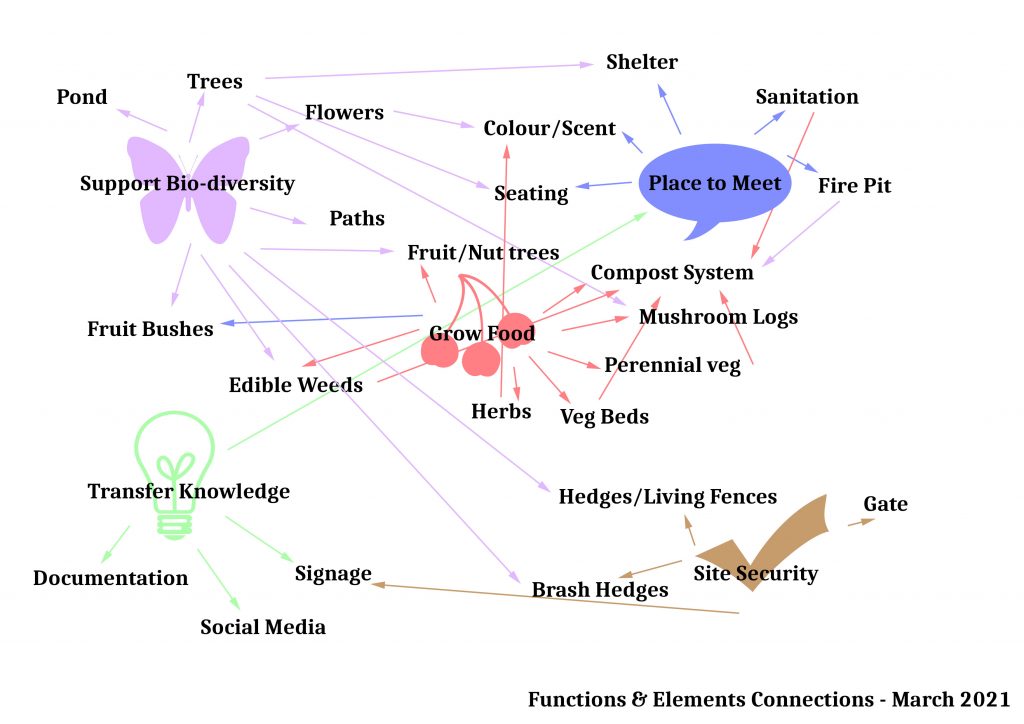
Access
Creating clear paths through the site and also access to harvest and maintain fruit trees will be critical to the success of this design.
Paths Options
I undertook a PMI analysis to explore different path options.
| Option | Positive | Minus | Interesting |
|---|---|---|---|
| No Paths | No effort No cost | Trample crops Soil compaction No sense of destination Waste of valuable humus | Wait and see where desire lines are created |
| No Covering | No cost No effort | No definition Will still need some way to define path Waste of valuable humus | Will become compacted and defined over time |
| Cardboard | Minimal effort No cost | Slippy Looks scruffy Short lived | Could use under composted brambles |
| Wood Chip | No cost Easy to lay Reduces evaporation Absorbs water Looks good Easy to move/change Adds to soil fertility | Needs access for bulk delivery A lot of effort to physically move to the site A lot of wood chip would be needed | Could be made on site by hiring a chipper |
| Planks/Pallet boards | No cost Materials readily available Reduces evaporation Solid surface to walk on Looks good Easy to define path | Chopping planks/dismantling pallets takes time May contain chemicals Need tools to chop Need a lot of material Slippery when wet | Pallet dismantling party? |
| Stepping Stones/Planks | Materials readily available (if using boards) No Cost Looks Good Helps reduce evaporation Flexible/Easy to change Less material needed Quick to install | Will need tools to cut boards/Dismantle pallets Dismantling takes time May contain chemicals (but less material involved than above) Slippery when wet | Make use of space between steps for growing – scented walkway? Pallet dismantling party? |
| Paving | Looks good Hard wearing | Expensive Heavy to move No access for bulk delivery Time consuming to lay | |
| Sticks/Twigs | Materials available on site Can be cut to size by hand Adds to soil fertility | Uneven to walk on Slippery Need a lot of material |
Decision to be made WITH client, but making a path of wooden ‘stepping stones’, or woodchip seem most suitable.
Vertical Access
The design needs to ensure easy access to fruit trees for harvest.
- Enough space must be left around the fruit trees to allow access to pick the fruit.
- Use semi-dwarfing or Medium root stocks (e.g. M26, M116 or M106 for Apple)
- Trees can be pruned to limit height – enabling picking without ladders.
- Underplant trees with herbaceous or fruit crops that are harvested before tree fruit ripens.
Boundaries & Security
Options for Fencing/Boundaries
Important considerations: Boundaries – keep low enough so people can see in/out of site, but keeps dogs out.
| Option | Positive | Minus | Interesting |
|---|---|---|---|
| Leave Open | No cost No effort | No physical boundary to site | |
| Brash Fence | Wildlife Haven Materials available Easy to construct Partially in place | Can look scruffy | Use as a framework for brambles Opportunity to share skills |
| Willow Fedge | Aesthetically pleasing Will grow well here | Need to source willow Needs regular maintenance Could grow too tall for purposes | Will be an opportunity to skill share |
| Wire supported climbers fence | Can use readily available cuttings Minimal cost (Chicken wire isn’t too expensive) Wire will stop unwanted dogs entering site | Can be slow to grow | If using flowering and fruiting climbers e.g. roses, honeysuckle, kiwi, ivy – supports biodiversity & provides yield |
| Living stick fence | Partially in place Framework for climbers No cost involved | Slow to grow Gappy |
As some of these options are already in place, it makes sense to continue with these and improve their effectiveness.
Potential shade loving hedging plants – Berberis, Eleagnus, Cotoneaster, Vibernum could be added to the living stick fence which would bulk out the hedge and provide food and shelter for birds and insects.
For the southern edge, there are no physical boundaries in place. Decision to be made WITH client, however, I strongly suggest the chicken wire & climber fence as can supports many different functions – food, scent, colour, food for birds & insects, supporting bio-diversity.
Growing in ground prone to water logging.
I investigated different approaches to growing in ground that is prone to water logging, although despite a wet winter the ground does not seem as wet this winter as it did in 2020.
Options to consider are:
- Use varieties and types of plants that can handle or thrive in wetter ground. This needs minimal intervention, both physical and financial.
- Use Hugelkultur techniques that take a plants roots above the level of standing water. We have plenty of wood on site, and nearby that could be used, and if creating paths we can re-use any soil that is removed in this process, We can also create our own compost in due course.
- Planting on mounds of soil – Planting on a mound of free draining soil in a shallow planting hole. This ensures that water runs away from the tree roots. The crown of the roots (if a tree or bush) should be about 8″ above ground level. Mulch well with after planting. Herbaceous shrubs can be planted in a similar way – almost like edge free raised beds.
- Divert Water – Moving soil, adding drains and ponds could work, but would need very careful consideration. Would changing the flow of water affect the long established trees? Would we damage root systems? Where would the water go? Into the canal? If so, we would need to bypass a solid footpath. A pond has also been (for now) ruled out of the design.
Any of the first three options would work well on the site, Perhaps a mix of all three to see what works well,
Shelter & Sanitation
Shelter
I looked at two options for the shelter.
| Option | Positive | Minus | Interesting |
|---|---|---|---|
| Tarp attached to trees | Low Cost Can be taken down when not in use Quick to install | Would need to leave up if we wanted to collect rain water. Less secure in poor weather Would need somewhere to store tarp when not in use | |
| Build a permanent wooden structure | Shelter might make the site look ‘used’ and attract volunteers Rainwater harvesting easier Can grow things up the structure | Might attract unwanted users | Use existing trees/pollarded trees as uprights Could build in storage and house information about the project |
I think using a Tarp as a shelter is a good option until the project is further established. We can then decide if we need something more permanent.
Handwashing
If people working on site are also to eat and socialise here, a handwashing station would be a good idea.
There is no water catchment on site at the moment, but rainwater could be harvested from the shelter easily, water can also be brought from home onto site as a stop-gap measure.
I would recommend building a Tippy Tap. This is a hands-free, low-cost, waste free & simple solution. Building the Tippy-tap would be a fun activity and also a chance to learn a new skill.
Toilet & Urinal
Is the site suitable for a compost toilet?
No, The site is small, and there is not the space to build a toilet. The amount of energy and materials needed to construct the toilet would outweigh the amount of people using the facility.
There is an option of building a urinal, or increasing the seclusion of the compost area to enable the compost bays to be used as urinals. This would mean that urine can be collected and used to help with the composting of waste.
There is a supermarket which has long opening hours nearby. Volunteers may be able to use these facilities.
Compost System
The compost system needs to be located away from the social area and away from the paths (so that they are not used as Dog Poo bins). They need to be located in a shady area. They need to be easily accessible by foot and by barrow from across the site.
Building a pile, makes the site look untidy, and it also means that people may not understand what the pile is.
Building bays means that the compost can be better managed. We can have 2 bays. One to mature and one for new additions. Building bays also makes it easier to add information and signage.
Signage
What do we need signage to do?
- Inform of readiness to harvest
- What it is
- How to use it
- What it looks like (for dormant season)
- Who we are
- What goes in compost
- Where to find out more information
- Jobs that need doing
